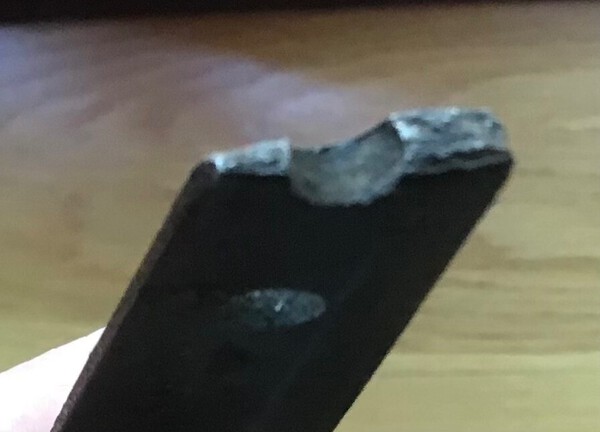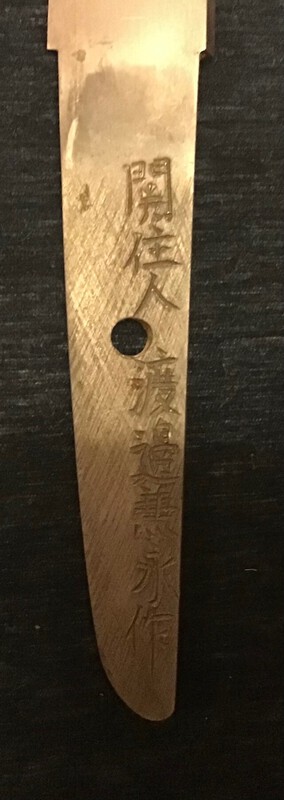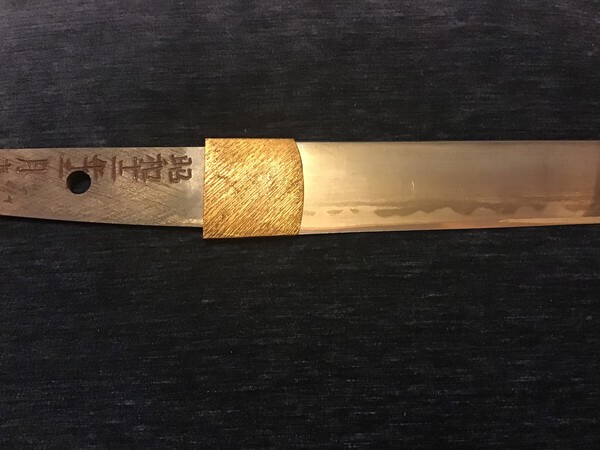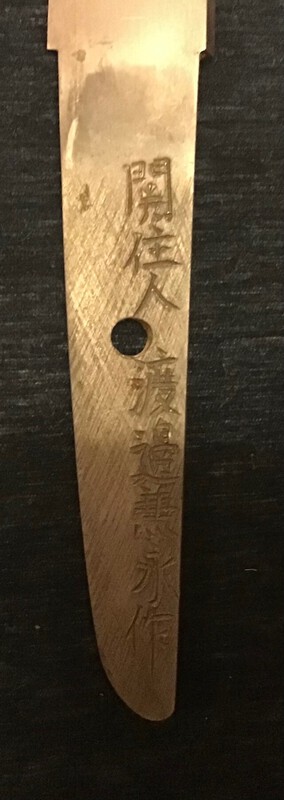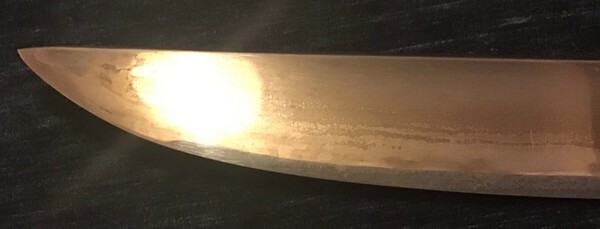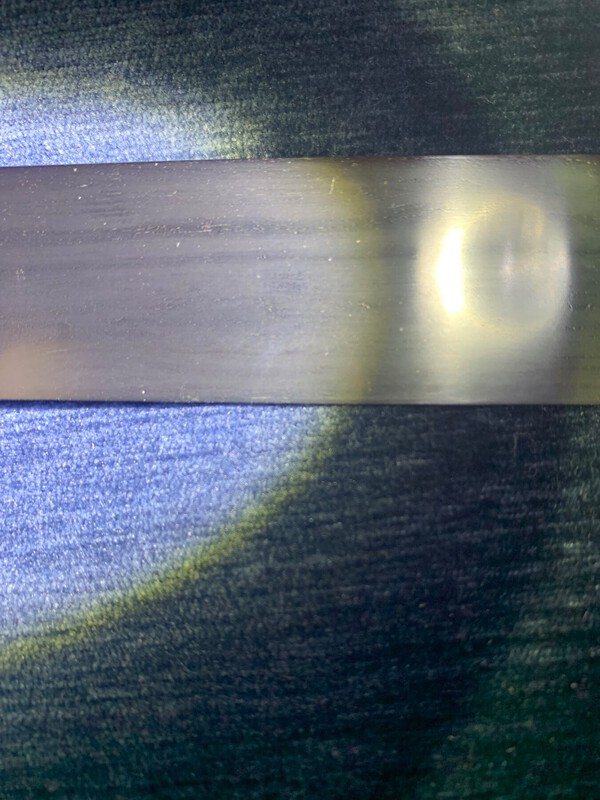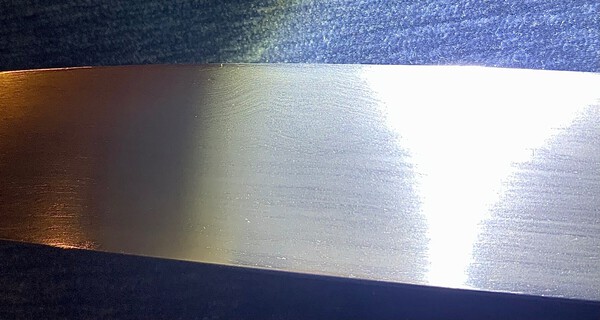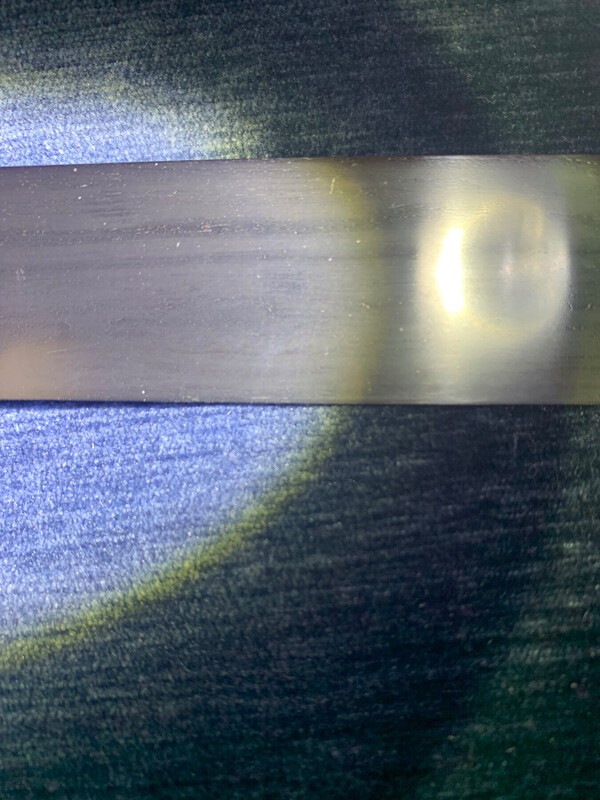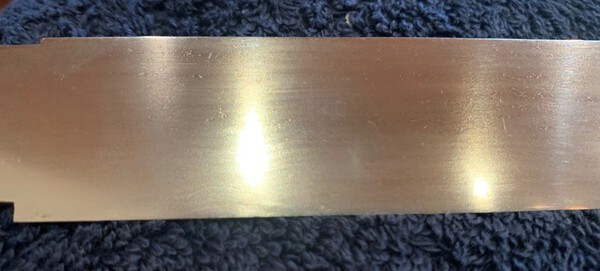
Matsunoki
Gold Tier-
Posts
3,019 -
Joined
-
Last visited
-
Days Won
57
Everything posted by Matsunoki
-
Thank you all for further comments…..I do truly appreciate your time and I respect your knowledge and expertise. What puzzles me is why we focus on a nakago that has been totally ruined by (several) reworkings. In hand it becomes a bit more obvious and my images are not great……sorry. It is (imo) o- suriage….you can see where it was just partially chiselled and then snapped off at the jiri (sorry I didn’t image that earlier) the last time someone butchered it leaving half an ana hanging off the end. The nakago also already has two (maybe 3) different age patinas on it and the large ana is obviously drilled…..you can see where the drill chuck hit it. All it tells me is that it tells me nothing useful ….so we default to the blade which tells us a lot more in my opinion. Similar Kiri yasurimei now cover the whole nakago but are obviously (imo) not original. There is a deep scour horizontally caused by reusing (imo) the old habaki at the last “refit” which now does not fit so snugly. My money is on the last refit being into Gunto mounts…..reusing old habaki, nice fresh large machi, nice big ana badly drilled……but at least it still has a nakago. I’ve seen worse though🙂😖 Anyway…..it’s a good debate
-
Jacques, thank you for your further comments. We must agree to differ. I cannot see how the size of the machi or the nakago shinogi tells us anything when an obviously already o-suriage nakago has then later been so extensively reworked. I think there is a very good chance that this blade emerged from WW2 koshirae so indeed it could have had anything done to it then. I go back to what I said earlier….what features of the blade make you think 20thC? The sugata is appropriate for Nanbokucho o-suriage including o-kissaki and deep motohaba. The visible hamon and hada look appropriate, there are many suguha hada openings- some quite large, the boshi which is quite complex also is appropriate etc etc.
-
Alex, of course it looks to have little age. There is absolutely none of the original nakago left so looking for a Nanbokucho nakago sugata or patina is pointless. For o-suriage koto (?) blades the nakago is often of little use in Kantei especially if it has been heavily reworked/reshaped as well as suriage/machi okuri. The nakago mune is sometimes seriously altered to allow the overall new blade sugata with a new tsuka fitted to look “right” ie the tsuka fits at the desired angle. I believe this blade emerged from WW2 koshirae……anything could have been done to it at that time. The remaining blade sugata and visible forging/tempering details are far more useful in forming an opinion…..in my opinion🙂
-
Brian, how about a comparison with the Mei on this one - https://collectorsmilitaria.com/a_tanto_presented_to_the_german_ambassador_to_japane_Eugen_Ott_051208s.htm regards Colin Brian….it looks spot on to me compared to Page 53 of Slough. What do you think? Colin.
-
Brian, how about a comparison with the Mei on this one - https://collectorsmilitaria.com/a_tanto_presented_to_the_german_ambassador_to_japane_Eugen_Ott_051208s.htm regards Colin
-
I am not sure if I should post this here or in the Military swords forum as it has a foot in both camps (so I’ve posted it in both…hope that is ok) It is not a military sword but is (I think/hope) by a good Showa smith. If I have got it right it is signed “Seki ju nin Watanabe Kanenaga Saku”and dated 1937. It is in terrible polish….remains of perpendicular scratches etc and is in a shirasaya that someone has adapted to hold it. There is thankfully no serious damage though. They are not great images but I used the lighting that at least showed some of the visible activity. It certainly looks lively but it’s “had a life”. Personally I’ve never seen nie that “heavy” or pronounced(if it is nie) There are also clouds and streams of fine black konie that won’t show in the images scattered in the ji. The polish obscures the hada. Any/all comments or observations greatly appreciated. I’m just getting into later blades….there are some still left in the UK! Nagasa 28.5cm (39.2 overall) motokasane 6.22mm (6.29 at thickest part of nakago)
-
-
-
I am not sure if I should post this here or in the General Nihonto forum. It is not a military sword but is (I think/hope) by a good Showa smith. If I have got it right it is signed “Seki ju nin Watanabe Kanenaga Saku”and dated 1937. It is in terrible polish….remains of perpendicular scratches etc and is in a shirasaya that someone has adapted to hold it. There is thankfully no serious damage though. They are not great images but I used the lighting that at least showed some of the visible activity. It certainly looks lively but it’s “had a life”. Personally I’ve never seen nie that “heavy” or pronounced(if it is nie) There are also clouds and streams of fine black konie that won’t show in the images scattered in the ji. The polish obscures the hada. Any/all comments or observations greatly appreciated. I’m just getting into later blades….there are some still in the UK! Nagasa 28.5cm (39.2 overall) motokasane 6.22mm (6.29 at thickest part of nakago)
-
Baba Yaga……I can only apologise for images. I have tried many different lightings ….natural, LED, halogen, daylight bulbs, bright, dim etc and at every possible angle…….but worn/old polish makes it nearly impossible to get good pics. There is a lot of hataraki that you can see with eye but it simply won’t image. Very frustrating. Thank you for looking. All the best. Colin.
-
Jacques, that is a very bold statement. Please can you tell me the features of the blade….hada, sugata, jihada, hamon, kissaki, boshi etc that make you think 20thC? The nakago (with all its confusion re the ana and machi) has obviously been so heavily modified that in my opinion it isn’t really much use in Kantei anyway……so we must look at the original work of the smith in the forging and tempering? However I know the condition is rather difficult…old worn polish etc.
-
Unusual theme. Classy. Quality. Opulent. I love it. …..great (jabara?) tsuka wrap as well.
-
George, thank you for excellent explanation and helpful image. Looking closely, I think the two at the base of the nakago are old but the two grouped closely nearer the machi are “difficult”. The one nearest the machi is large and on one side the diameter is far bigger than the other side and it looks heavily “worked”. I’m thinking that one is drilled and badly reshaped. The smaller one next to it looks as if it has been affected by the filing work done on the large one ….if that makes sense. The rim has been brightened although the internal patina is dark. That would further fit my theory that it had WW2 mounts….maybe. If only it could talk. It looks like all opinions are in and the consensus seems to be “possibly Nanbokucho Yamato Shizu”. Could anyone give me an idea re it’s scarcity? So much more is known in the West about Nihonto now compared to when I had my first collection (30-35 years ago) so where does this sit in modern day thinking…..common? rare? worth polishing/shinsa? interesting ? shame about the………. All opinions welcome, Thanks again. Colin
-
Jacques…..Please excuse me but I do not understand. I agree the machi look crisp but surely that suggests machi-okuri rather than “suriage yesterday”? The habaki does not fit quite as snugly as it should so maybe it was reused rather than a new one made? I have a feeling that this blade emerged from a WW2 koshirae. I acquired it and several other swords from a confirmed “blade man” and it was bought by him at a USA show over 30 years ago. The old samurai saya fits but is quite a bit longer than the blade and has had the kurigata removed (and later replaced with a home made one). The heavy iron saya mounts are heavily rusted…..once had a leather cover? The tsuka has nothing to do with the blade and is matched. Lots of clues but nothing definite!. The seller strongly believed it was a very old blade….Nanbokucho was his call. George….I will have a very close look at the ana later today but can you please give me any clues re what to look for?. I lack knowledge regarding the tell-tale signs. I guess if it was refitted for WW2 it would have at least one drilled? Thank you all again especially those who have gone to the trouble of researching and posting comparison images. Colin
-
Again, thank you all for your replies. I know it is very difficult when we only have images and the sword is not in great polish. However when handling the blade it really does not feel shinshinto or even muromachi. I do appreciate that this sugata rightly raises suspicions. I believe none of the original nakago is present but already the blade is noticeably thinner than the nakago so it would seem to have had a few polishes even since the nakago was (totally?)reworked. There are also several suguha forging openings in various locations (but not in the hamon)….mostly tolerable…but I have imaged the worst earlier in the thread. The hada and steel colour (in my opinion) looks koto although I know that is not reliably definitive! Here in the uk we are severely limited in our abilities/options to get a sword polished and through Shinsa, in fact we are pretty much starved of swords! I do envy you lucky collectors in the USA, Australia etc. That’s why I am so grateful for having access to the expertise on this forum. Any/all further comments eagerly awaited. Stay we’ll all of you. Colin
-
Thank you all so much. Imaging the hamon at the machi is difficult but I’ve given it a go! Hamon seems to disappear off down the nakago. Don’t think it’s shinshinto….there are many forging openings…images attached.
-
-
-
Hello from the UK. I am returning to Nihonto after a gap of very many years. Please excuse all errors and omissions. I have acquired this blade and I would greatly appreciate some help figuring out what it is. For what it is worth, I think it could be a greatly cut down Nanbokucho Tachi but I lack the knowledge (or courage) to try beyond that. It is in the remains of an old Japanese polish so it has been very difficult to get good images. The hada looks to be a fairly coarse flowing masame with some ayasugi like inclusions in the hamon and a few o-hada areas. The hamon appears to be suguha and still looks fairly healthy with a bright thin nioi line mostly visible.The boshi looks kaen/hakkikake on one side and possibly Jizo on the other? There is konie scattered along the hamon, some in sunagashi or ayasugi form. I believe there is nothing left of the original nakago or if there is it has been heavily reworked. The kissaki is pretty large! The measurements - Nagasa. 63cm (overall 77cm) motohaba 32.24mm sakihaba 24.62 mm motokasane 6.85 mm sakikasane 6.24mm kissaki length 87.81mm I will post more images below. I’m very new to forums/ social media so I haven’t quite got the hang of it yet…..and as I’m rather “old school” my tech abilities are somewhat lacking……sorry! Sincere thanks in advance. Colin.
-
This aikuchi koshirae is a typical example of the opulent and high quality work probably done in the Meiji period. It is possibly for a rich merchant, unlikely for a Samurai but most likely for sale to the “important” Westerners that were helping Japan to “modernise”. They can contain blades of varying age and quality and sometimes re-use older similar fittings that do not always match perfectly. However they often come with en-suite silver mounts and some that use the finest Meiji Kinko mixed metal mounts can take your breath away for sheer quality of workmanship. This example shows the skills and quirky taste of the lacquer artisan beautifully. It is super quality……and very desirable if your taste is for eye-catching koshirae. It would have appealed greatly to the “gaijin” present in Japan following the Meiji restoration.
-
-

